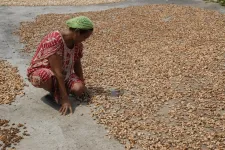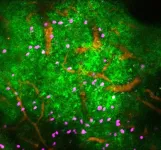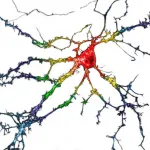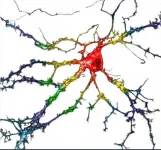Two compounds can make chocolate smell musty and moldy
2021-04-28
(Press-News.org) Chocolate is a beloved treat, but sometimes the cocoa beans that go into bars and other sweets have unpleasant flavors or scents, making the final products taste bad. Surprisingly, only a few compounds associated with these stinky odors are known. Now, researchers reporting in ACS' Journal of Agricultural and Food Chemistry have identified the two compounds that cause musty, moldy scents in cocoa -- work that can help chocolatiers ensure the quality of their products.
Cocoa beans, when fermented correctly, have a pleasant smell with sweet and floral notes. But they can have an off-putting scent when fermentation goes wrong, or when storage conditions aren't quite right and microorganisms grow on them. If these beans make their way into the manufacturing process, the final chocolate can smell unpleasant, leading to consumer complaints and recalls. So, sensory professionals smell fermented cocoa beans before they are roasted, detecting any unwanted musty, moldy, smoky or mushroom-like odors. Even with this testing in place, spoiled beans can evade human noses and ruin batches of chocolate, so a more objective assessment is needed for quality control. In previous studies, researchers used molecular techniques to identify the compounds that contribute to undesirable smoky flavors, but a similar method has not clarified other volatile scent compounds. So, Martin Steinhaus and colleagues wanted to determine the principal compounds that cause musty and moldy odors in tainted cocoa beans.
The researchers identified 57 molecules that made up the scent profiles of both normal and musty/moldy smelling cocoa beans using gas chromatography in combination with olfactometry and mass spectrometry. Of these compounds, four had higher concentrations in off-smelling samples. Then, these four compounds were spiked into unscented cocoa butter, and the researchers conducted smell tests with 15-20 participants. By comparing the results of these tests with the molecular content of nine samples of unpleasant fermented cocoa beans and cocoa liquors, the team determined that (-)-geosmin -- associated with moldy and beetroot odors -- and 3-methyl-1H-indole -- associated with fecal and mothball odors -- are the primary contributors to the musty and moldy scents of cocoa beans. Finally, they found that (-)-geosmin was mostly in the beans' shells, which are removed during processing, while 3-methyl-1H-indole was primarily in the bean nib that is manufactured into chocolate. The researchers say that measuring the amount of these compounds within cocoa beans could be an objective way to detect off-putting scents and flavors, keeping future batches of chocolate smelling sweet.
INFORMATION:
The authors acknowledge funding from the German Ministry of Economic Affairs and Energy via the German Federation of Industrial Research Associations (AiF) and the Industrial Collective Research (IGF).
The abstract that accompanies this paper can be viewed here.
The American Chemical Society (ACS) is a nonprofit organization chartered by the U.S. Congress. ACS' mission is to advance the broader chemistry enterprise and its practitioners for the benefit of Earth and all its people. The Society is a global leader in promoting excellence in science education and providing access to chemistry-related information and research through its multiple research solutions, peer-reviewed journals, scientific conferences, eBooks and weekly news periodical Chemical & Engineering News. ACS journals are among the most cited, most trusted and most read within the scientific literature; however, ACS itself does not conduct chemical research. As a leader in scientific information solutions, its CAS division partners with global innovators to accelerate breakthroughs by curating, connecting and analyzing the world's scientific knowledge. ACS' main offices are in Washington, D.C., and Columbus, Ohio.
To automatically receive news releases from the American Chemical Society, contact newsroom@acs.org.
Follow us: Twitter | Facebook
ELSE PRESS RELEASES FROM THIS DATE:
2021-04-28
When seasonal rains arrive late in Indonesia, farmers often take it as a sign that it is not worth investing in fertilizer for their crops. Sometimes they opt out of planting annual crops altogether. Generally, they're making the right decision, as a late start to the rainy season is usually associated with the state of El Niño Southern Oscillation (ENSO) and low rainfall in the coming months.
New research published in the Nature journal Scientific Reports shows that ENSO, the weather-shaping cycle of warming and cooling of the Pacific Ocean along the Equator, is a strong predictor of cacao harvests up to two years before a harvest.
This is potentially ...
2021-04-28
CHAMPAIGN, Ill. -- A higher ratio of green spaces at the county level is associated with a lower racial disparity in coronavirus infection rates, according to a new study. It is the first study to report the significant relationship between the supply of green spaces and reduced disparity in infectious disease rates.
The research team included William Sullivan, a landscape architecture professor at the University of Illinois Urbana-Champaign, and was led by Bin Jiang, a landscape architecture professor at The University of Hong Kong who received his Ph.D. at Illinois, and Yi Lu, an architecture professor at City University of Hong Kong. They reported their findings in the journal Environment ...
2021-04-28
UNIVERSITY PARK, Pa. -- There are hard-to-please customers in almost every industry, with certain people being picky about which clothes, houses and even romantic partners they will consider.
A new series of studies has found that shopper pickiness can go beyond shopping for the "best" option. The researchers define what it means to be "picky" and also developed a scale for measuring shopper pickiness.
Margaret Meloy, department chair and professor of marketing at Penn State, said the findings could help companies devise the best strategies for satisfying their pickier customers.
"If a company knows they have a lot of picky customers, they may need to change the way they reward salespeople or dedicate specific salespeople to their pickiest customers, because ...
2021-04-28
In collaboration with VGP, the research group has published a research paper in Nature on platypus and echidna genomes early this year (see report in the right column). In the Nature current special issue, the research group published another study on the genome of the common marmoset, an important primate model for neurodegenerative diseases, drug development and other biomedical research.
The genome includes two sets of chromosomes, one inherited from the mother, the other from the father. In traditional genome sequencing efforts including the human genome project, the sequencing only produced a mosaic reference ...
2021-04-28
While evolution is normally thought of as occurring over millions of years, researchers at the University of California, Irvine have discovered that bacteria can evolve in response to climate change in 18 months. In a study published in the Proceedings of the National Academy of Sciences, biologists from UCI found that evolution is one way that soil microbes might deal with global warming.
Soil microbiomes - the collection of bacteria and other microbes in soil - are a critical engine of the global carbon cycle; microbes decompose the dead plant material to recycle nutrients back into the ecosystem and release carbon back into the atmosphere. Multiple environmental factors influence the composition and functioning of soil microbiomes, ...
2021-04-28
The neurotransmitter noradrenaline, which plays a key role in the fight-or-flight stress response, impairs immune responses by inhibiting the movements of various white blood cells in different tissues, researchers report April 28th in the journal Immunity. The fast and transient effect occurred in mice with infections and cancer, but for now, it's unclear whether the findings generalize to humans with various health conditions.
"We found that stress can cause immune cells to stop moving and prevents immune cells from protecting against disease," says senior study author University of Melbourne's Scott Mueller (@SMuellerLab) of the Peter Doherty Institute for Infection and Immunity (Doherty Institute). "This is novel because it was not known that ...
2021-04-28
Psychedelic drugs have shown promise for treating neuropsychiatric disorders such as depression and posttraumatic stress disorder. However, due to their hallucinatory side effects, some researchers are trying to identify drugs that could offer the benefits of psychedelics without causing hallucinations. In the journal Cell on April 28, researchers report they have identified one such drug through the development of a genetically encoded fluorescent sensor--called psychLight--that can screen for hallucinogenic potential by indicating when a compound activates the serotonin 2A receptor.
"Serotonin reuptake inhibitors have long been used for treating depression, but we don't ...
2021-04-28
A genetically encoded sensor to detect hallucinogenic compounds has been developed by researchers at the University of California, Davis. Named psychLight, the sensor could be used in discovering new treatments for mental illness, in neuroscience research and to detect drugs of abuse. The work is published April 28 in the journal Cell.
Compounds related to psychedelic drugs such as LSD and dimethyltryptamine (DMT) show great promise for treating disorders such as depression, post-traumatic stress disorder, and substance use disorder. These drugs are called psychoplastogens ...
2021-04-28
It's one of the most audacious projects in biology today - reading the entire genome of every bird, mammal, lizard, fish, and all other creatures with backbones.
And now comes the first major payoff from the Vertebrate Genome Project (VGP): near complete, high-quality genomes of 25 species, Howard Hughes Medical Institute (HHMI) Investigator Erich Jarvis with scores of coauthors report April 28, 2021, in the journal Nature. These species include the greater horseshoe bat, the Canada lynx, the platypus, and the kākāp? parrot - one of the first high-quality ...
2021-04-28
Researchers have big ideas for the potential of quantum technology, from unhackable networks to earthquake sensors. But all these things depend on a major technological feat: being able to build and control systems of quantum particles, which are among the smallest objects in the universe.
That goal is now a step closer with the publication of a new method by University of Chicago scientists. Published April 28 in Nature, the paper shows how to bring multiple molecules at once into a single quantum state--one of the most important goals in quantum physics.
"People have been trying to do this for decades, so we're very excited," said senior author Cheng Chin, a professor of physics at UChicago who said he has wanted ...
LAST 30 PRESS RELEASES:
[Press-News.org] Two compounds can make chocolate smell musty and moldy





